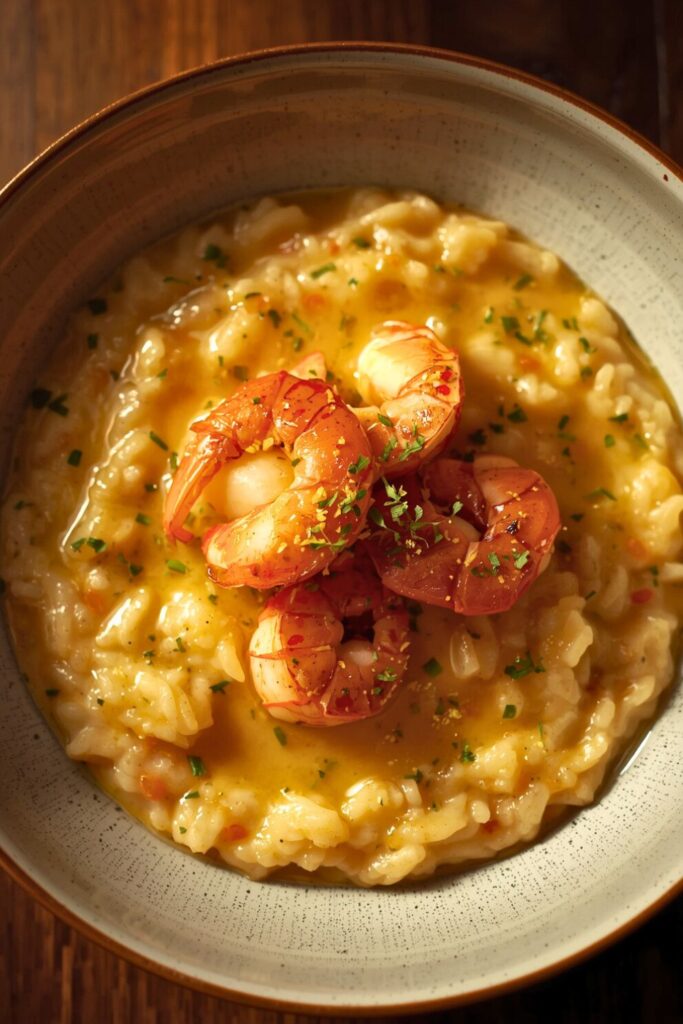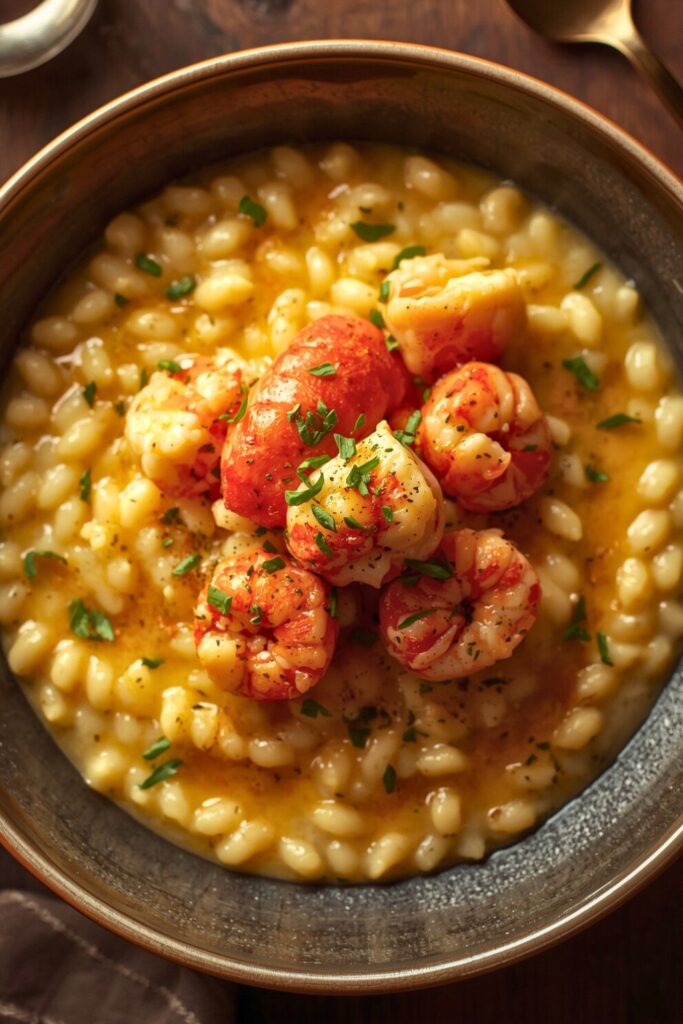You know that feeling when your brain says “fast food” but your taste buds demand something indulgent, comforting, and a little luxurious? That’s the tug of war most weeknights throw at you. You want comfort, you want flavor, you want a dish that feels like a reward, but you definitely don’t want to spend hours chained to the stove. Enter Lemon Butter Lobster Risotto, a recipe that manages to feel elegant and soul warming while still being surprisingly doable on an ordinary evening.
I first pulled this together on one of those “what on earth do I cook” nights. There was lobster waiting in the freezer, a wedge of Parmesan calling from the fridge, and that bag of Arborio rice I’d been ignoring for weeks. The butter melted with a low hiss, garlic followed with that unmistakable aroma, and saffron threads bloomed golden in the pan. The moment the lobster met the lemon infused sauce, the whole kitchen shifted, it smelled like a restaurant, but it was just my weekday dinner.
What landed in the bowl was creamy, rich, and deeply satisfying: tender risotto grains carrying the tang of lemon, the silkiness of butter, and generous chunks of lobster layered throughout. It looked indulgent, tasted bold, and yet came together with ease. Trust me, once you taste this Lemon Butter Lobster Risotto, you’ll wonder why you didn’t make it sooner, and you’ll find yourself coming back to it again and again.
Why This Lemon Butter Lobster Risotto Changes Everything

Let me tell you what makes this dish absolutely brilliant. First off, that lobster isn’t just thrown on top like some afterthought garnish. We’re building layers of flavor here, the shells become liquid gold (aka lobster stock), the meat gets a quick sear for texture, and everything comes together in this creamy, dreamy rice that’s been drinking up all those beautiful flavors.
The lemon? That’s not just for color, friend. It cuts through the richness and makes each bite feel fresh instead of heavy. And the butter, h, the butter, that’s what makes everything silky and luxurious without being over the top.
This isn’t just dinner. It’s an experience that happens to involve food. When you master this Lemon Butter Lobster Risotto recipe, you’re not just learning a dish, you’re unlocking a technique that’ll transform how you think about cooking seafood.
What Makes This Recipe Special
Most lobster risotto recipes treat the lobster like an expensive add in. That’s where they go wrong. In this version, we’re treating that lobster like the star it deserves to be. Every part of it contributes something different, shells for depth, meat for sweetness, and that natural brininess that makes everything taste like it came straight from a seaside kitchen.
The technique here separates good risotto from the kind that makes people close their eyes and sigh. We’re gonna talk about the toasting, the stirring rhythm, and why your wine choice actually matters more than you think.
There’s also the cultural angle that makes this dish fascinating. While traditional Italian risotto rarely features lobster (that’s more of a modern innovation), the technique we’re using honors that ancient Venetian tradition of slow stirred rice while celebrating the incredible seafood that makes coastal cooking so special.
Essential Ingredients for Perfect Lemon Butter Lobster Risotto
For the Lobster Stock Base
- 2 whole lobsters (1.5 lbs each) or 4-6 lobster tails
- 8 cups cold water
- 1 large onion, roughly chopped
- 2 celery stalks with leaves, chopped
- 2 bay leaves (fresh if you’ve got them)
- Black peppercorns (about a tablespoon)
- 1 carrot, roughly chopped
- Fresh parsley stems (save the leaves for garnish)
For the Risotto Base
- 1½ cups Arborio rice (don’t even think about substituting regular rice here)
- 4-5 cups warm lobster stock
- ½ cup dry white wine (something you’d actually drink)
- 1 large shallot, finely minced
- 3 cloves garlic, minced
- 4 tablespoons European butter, divided
- 2 tablespoons extra virgin olive oil
- ¼ cup heavy cream
- Zest and juice of 2 large lemons
- ½ cup Parmigiano Reggiano, freshly grated
- Sea salt and white pepper to taste
- Fresh chives and parsley for garnish
Smart Swaps That Actually Work
Can’t get fresh lobster? Frozen lobster tails work beautifully, just thaw ’em properly overnight in the fridge. The key is treating frozen seafood with the same respect as fresh. No lobster stock? Fish stock mixed with a splash of clam juice creates depth, though you’ll miss some of that distinctive lobster flavor that makes this recipe sing.
For the wine, anything crisp and dry works perfectly. Pinot Grigio, Sauvignon Blanc, or even a dry Riesling. Just don’t use cooking wine, that stuff is basically salted sadness in a bottle. I learned this lesson the hard way years ago.
If you’re dairy sensitive, swap the butter for top quality olive oil and skip the cream. The Parmesan’s trickier to replace, but nutritional yeast gives you that nutty, umami flavor that makes risotto sing. Won’t be traditional, but it’ll still be delicious.
Here’s an insider secret about picking ingredients: when choosing lobster, look for ones that feel heavy for their size. That means more meat, less water. For lemons, roll them on the counter with pressure before zesting, you’ll get way more oils released.
Step by Step Mastery: Creating Lemon Butter Lobster Risotto

Building Your Foundation: The Lobster Stock
Start by cooking those lobsters in salted boiling water, about 8 minutes for whole ones, 6 for tails. Pull ’em out and let them cool enough to handle. Remove all that beautiful meat and set it aside, covered. Don’t throw away those shells, they’re about to become liquid gold.
Toss the shells into a pot with your aromatics and water. Bring it to a boil, then let it simmer for about 45 minutes. You’ll know it’s ready when your kitchen smells like the best seafood restaurant you’ve ever been to. Strain it through a fine mesh, and you’ve just made something most people pay good money for.
Here’s a trick I learned from an old Italian chef: save some of the lobster cooking liquid. That concentrated flavor is pure magic when you need to thin your risotto later. Store it separately, it’s like having a flavor insurance policy.
The Risotto Dance Begins
Heat your olive oil and half the butter in a heavy bottomed pan, and I mean heavy. Thin pans are risotto’s worst enemy because they create hot spots that’ll burn your rice faster than you can say “disaster.”
Add your minced shallot and let it get soft and fragrant. This takes about 3 minutes, and don’t rush it. Raw shallot in finished risotto is nobody’s friend. Add the garlic for the last minute, it burns faster than you think and bitter garlic ruins everything.
Now comes the important part: toasting the rice. Add your Arborio and stir it around until each grain is coated with that buttery mixture. You’ll hear it start to crackle slightly, that’s the sound of flavor developing. Takes about 2-3 minutes, and this step is crucial for proper texture.
Pour in your wine and listen to that beautiful sizzle. Stir until it’s mostly absorbed, then we begin the meditation that is risotto stirring. This is where patience becomes your best friend.
The Rhythm Method for Perfect Texture
Add your warm stock one ladle at a time. And yes, it needs to be warm, cold stock shocks the rice and messes up the whole creamy thing we’ve got going. Stir frequently but not constantly. I like to think of it as a conversation with the rice, check in regularly, but don’t be clingy.
Each addition should be absorbed before you add the next. This takes patience, maybe 20-25 minutes total. Put on some music, pour yourself a glass of that wine you’re cooking with, and enjoy the process. Good risotto can’t be rushed.
You’ll know it’s getting close when the rice starts looking creamy but the grains still have just a tiny bit of bite. That’s “al dente” in risotto world, and it’s exactly what we’re after for this Lemon Butter Lobster Risotto.
The Grand Finale: Bringing It Together
Cut your lobster meat into bite sized pieces, nothing too small, we want people to know they’re eating lobster. In the last few minutes of cooking, fold in the remaining butter, cream, lemon zest, and most of that Parmesan. Taste and adjust, you might want more lemon, maybe a pinch of salt.
Add the lobster meat right at the end. It’s already cooked, so we’re just warming it through. Overcooked lobster turns rubbery, and we’ve come too far for that kind of tragedy. Gentle folding is key here.
The final texture should be all’onda, meaning it flows like waves when you shake the pan. Too thick? Add a splash of warm stock. Too loose? Let it cook another minute or two.
The Science Behind Perfect Lemon Butter Lobster Risotto
Let’s talk about why this method works so well. Arborio rice is basically designed for risotto, those short, plump grains are loaded with amylopectin, a starch that creates that signature creaminess when you stir it just right. The constant stirring releases that starch gradually, creating a sauce from the inside out.
The wine isn’t just for flavor (though it definitely adds that). The acid actually helps break down the outer layer of the rice, making it easier for those starches to release. It’s chemistry, but delicious chemistry that’s been perfected over centuries.
That warm stock trick? Cold liquid would shock the rice and stop the cooking process every time you add it. We want gentle, consistent cooking that lets those starches do their thing without getting stressed. Temperature control is everything in risotto.
The lemon serves multiple purposes beyond flavor. The acid brightens the dish, cuts through richness, and actually helps preserve the lobster’s delicate texture. It’s why Mediterranean coastal cooking relies so heavily on citrus with seafood.
Tool Talk That Matters
A heavy bottomed pan distributes heat evenly, preventing those burnt spots that’ll ruin your day. Cast iron, enameled cast iron, or heavy gauge stainless steel all work beautifully. Thin pans are risotto killers.
Keep that stock warm in a separate pot. A ladle’s your best friend here, easier than pouring and gives you better control over how much you’re adding. Some chefs swear by having two ladles, but one works fine if you’re organized.
A wooden spoon is traditional and works well because it won’t scratch your pan, but honestly, any spoon works as long as you’re not scraping the bottom aggressively. The key is gentle, consistent stirring.
Understanding the Cultural Context
While purists might argue that lobster doesn’t belong in traditional Italian risotto, this dish represents the beautiful evolution of cooking. It takes the fundamental technique that Venetian cooks perfected centuries ago and applies it to ingredients that showcase the best of coastal cuisine.
The technique itself is ancient, slow cooked rice with careful attention to texture and flavor. What we’re doing is honoring that tradition while celebrating the incredible seafood that makes coastal cooking so special.
Making Your Lemon Butter Lobster Risotto Beautiful & Delicious
Plate this in warm bowls, risotto gets sad and thick when it hits cold dishes. A simple sprinkle of fresh chives adds color and a mild onion flavor that complements without competing. Maybe add a few microgreens if you’re feeling fancy.
If you’re going full restaurant mode, save a few pieces of the prettiest lobster meat and arrange them on top. Drizzle with a tiny bit of good olive oil and maybe a crack of fresh black pepper. A small wedge of lemon on the side never hurts either.
The presentation should feel effortless but intentional. This isn’t about complicated plating, it’s about showing off those beautiful ingredients you’ve worked so hard to prepare perfectly.
Wine Pairings That Sing
Wine wise, that same crisp white you cooked with is perfect. Sancerre, Chablis, or a good Pinot Grigio all work beautifully. Champagne works too, there’s something about bubbles with lobster that feels celebratory and cuts through richness perfectly.
For sides, keep it simple so your Lemon Butter Lobster Risotto stays the star. A light arugula salad with lemon vinaigrette echoes the citrus theme. Maybe some crusty bread for sopping up any leftover creamy goodness, but honestly, there shouldn’t be leftovers.
Storage and Reheating Tips
Risotto’s best served immediately, but life happens. If you need to store it, spread it thin on a sheet pan to cool quickly, then refrigerate for up to two days. To reheat, add warm stock gradually while stirring gently over low heat until it returns to that creamy consistency.
Never microwave risotto, it turns gluey and sad. Always reheat on the stove with patience and a little extra liquid.
Advanced Techniques for Lemon Butter Lobster Risotto Masters
Once you’ve nailed the basics, try these variations. Toast the rice with a splash of cognac before adding wine, it adds incredible depth. Or infuse your butter with fresh herbs by letting them steep in melted butter for 30 minutes before using.
For extra luxury, finish with a dollop of crème fraîche instead of regular cream. The slight tanginess plays beautifully with the lemon and adds richness without heaviness.
Consider seasonal variations too. Spring peas and fresh mint in early summer. Roasted cherry tomatoes in peak season. The technique stays the same, but you can adapt the flavors to what’s best right now.
Bringing It All Together: Your Lemon Butter Lobster Risotto Journey

This Lemon Butter Lobster Risotto isn’t just about feeding people, it’s about creating a moment. The kind of meal that makes everyone put their phones down and actually taste their food. The kind that makes ordinary Tuesday feel special and turns dinner into an event.
The real secret isn’t in any fancy technique or expensive ingredient. It’s in understanding that good cooking is about patience, attention, and respect for your ingredients. Treat that lobster well, give your rice the time it needs, and don’t rush the process.
Once you’ve made this a few times, you’ll start to feel the rhythm. You’ll know by sound when the wine’s absorbed, by smell when the shallots are perfect, by texture when the risotto’s ready. That’s when cooking stops being about following recipes and starts being about creating something beautiful.
This recipe represents everything I love about cooking, tradition meeting innovation, technique serving flavor, and the magic that happens when quality ingredients are treated with respect and patience.
Frequently Asked Questions About Lemon Butter Lobster Risotto
Can I make this ahead of time?
Risotto’s one of those dishes that’s best served immediately, but here’s a chef trick: you can par cook it to about 80% done, spread it on a sheet pan to cool quickly, then finish it off when you’re ready to serve. Add a splash of warm stock to loosen it up and finish with your butter, cheese, and lobster.
What if I can’t find Arborio rice?
Carnaroli or Vialone Nano work beautifully, they’re both Italian short grain varieties with similar starch content. In a pinch, sushi rice can work, though the texture won’t be quite the same. Regular long grain rice? That’s gonna be a hard no from me.
My risotto turned out gluey. What went wrong?
Over stirring is usually the culprit, or adding stock that’s too hot. You want to stir frequently, but not constantly. Think of it like this: check in with your risotto regularly, but don’t helicopter parent it. Also, make sure your stock isn’t boiling when you add it.
Can I use frozen lobster meat instead of whole lobsters?
Absolutely, though you’ll miss out on making that incredible stock from the shells. If you go this route, use a good fish or seafood stock as your base and maybe add a splash of dry sherry for extra depth. The flavor won’t be quite as complex, but it’ll still be delicious.
How do I know when the risotto is perfectly done?
The rice should be creamy but still have slight firmness when you bite into it, that’s al dente. It should flow like lava when you shake the pan, but not be soupy. If you can draw a line through it with your spoon and it holds for a second before filling back in, you’re golden.

Swiftly Captions by Tina Smith — Quick, flavorful food recipes made simple, bringing fresh inspiration to your kitchen every day






